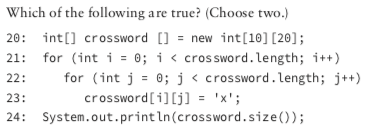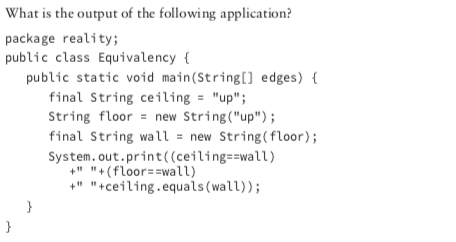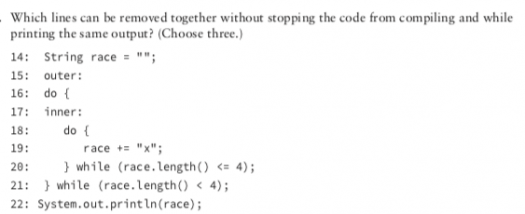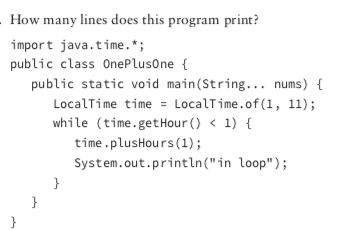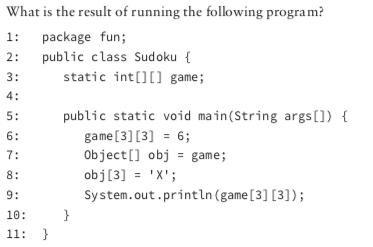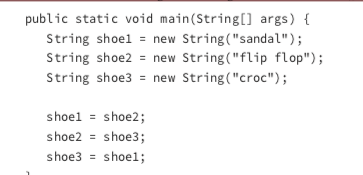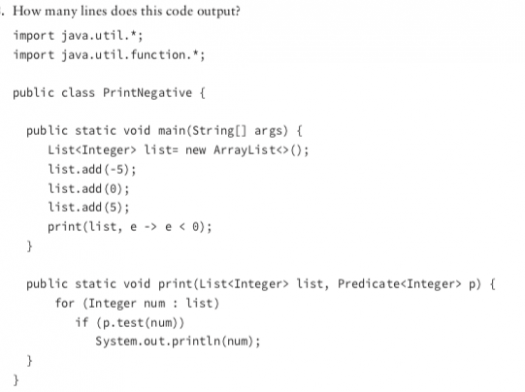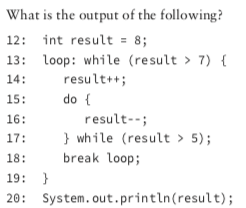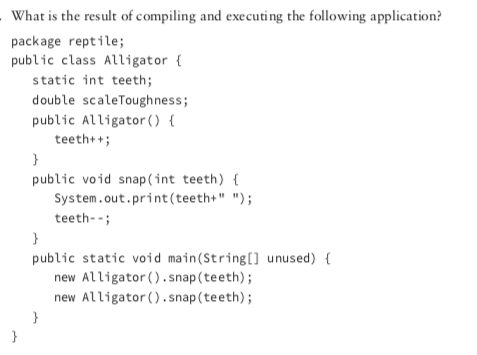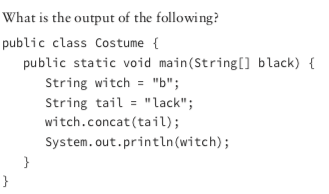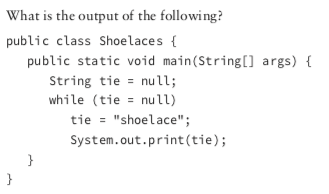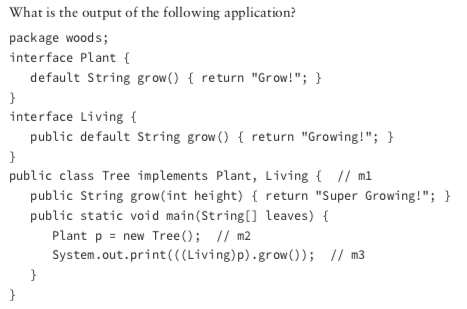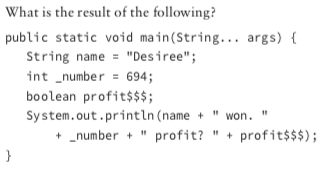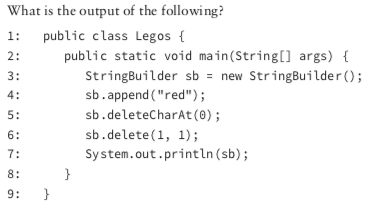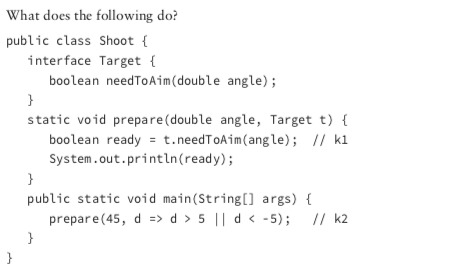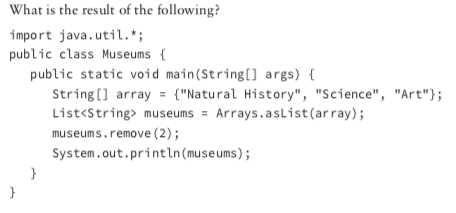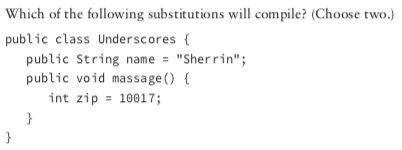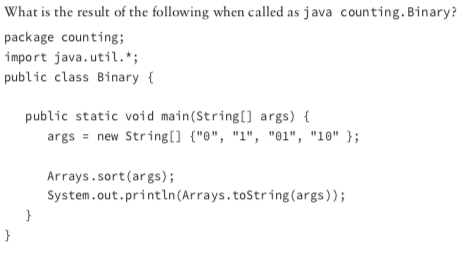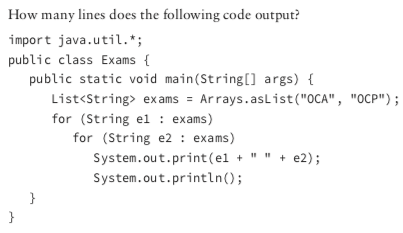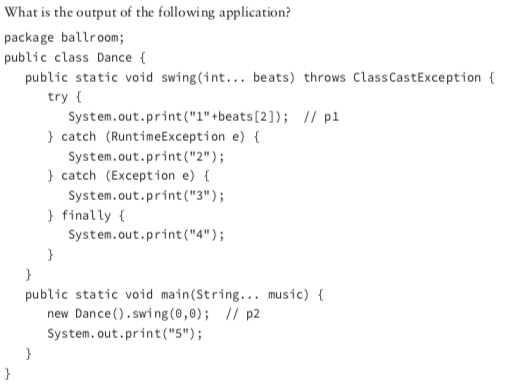Oracle Certified Java Associate Exam Quiz!

This Oracle Certified Java Associate Exam Quiz assesses knowledge in Java programming and its principles. It tests code comprehension, error handling, and understanding of JavaBeans and immutable objects, preparing learners for certification.
- 1.
Follow the instructions in the image.
- A.
Cars
- B.
Cars carts
- C.
Ccars arts
- D.
The code does not compile.
- E.
The code compiles but throws an exception at runtime.
Correct Answer
E. The code compiles but throws an exception at runtime.Explanation
The given code compiles successfully without any syntax errors. However, it will throw an exception at runtime because the code tries to access an index that is out of bounds in the second line. The variable "cars" is an array with a size of 4, but the code tries to access the element at index 4, which is not valid. This will result in an "IndexOutOfBoundsException" being thrown when the code is executed.Rate this question:
-
- 2.
Follow the instructions in the image.
- A.
–,+,=,--
- B.
%,*,/,+
- C.
=,+,/,*
- D.
^,*,-,==
- E.
*,/,%,--
Correct Answer(s)
C. =,+,/,*
E. *,/,%,--Explanation
The answer is "=,+,/,*, *, /, %, --". The given sequences are a combination of mathematical operators and symbols. The answer is formed by selecting the operators and symbols from each sequence in the order they appear.Rate this question:
-
- 3.
Which of the following are valid JavaBean signatures?
- A.
Public byte getNose(String nose)
- B.
Public void setHead(int head)
- C.
Public String getShoulders()
- D.
Public long isMouth()
- E.
Public void gimmeEars()
- F.
Public boolean isToes()
Correct Answer(s)
B. Public void setHead(int head)
C. Public String getShoulders()
F. Public boolean isToes()Explanation
The given answer lists three valid JavaBean signatures. In JavaBean, a valid getter method should start with "get" followed by the property name with the first letter capitalized. Therefore, "public String getShoulders()" is a valid getter method. Similarly, a valid setter method should start with "set" followed by the property name with the first letter capitalized. Therefore, "public void setHead(int head)" is a valid setter method. Lastly, a boolean property can also have a getter method starting with "is" followed by the property name with the first letter capitalized. Therefore, "public boolean isToes()" is a valid getter method for a boolean property.Rate this question:
-
- 4.
Follow the instructions in the image.
- A.
One line needs to be changed for this code to compile.
- B.
Two lines need to be changed for this code to compile.
- C.
Three lines need to be changed for this code to compile.
- D.
If the code is fixed to compile, none of the cells in the 2D array have a value of 0
- E.
If the code is fixed to compile, half of the cells in the 2D array have a value of 0.
- F.
If the code is fixed to compile, all of the cells in the 2D array have a value of 0.
Correct Answer(s)
A. One line needs to be changed for this code to compile.
E. If the code is fixed to compile, half of the cells in the 2D array have a value of 0.Explanation
The correct answer is "One line needs to be changed for this code to compile." because it suggests that there is a single line in the code that needs to be modified in order for it to compile successfully. This implies that there is only one error or mistake in the code that is preventing it from compiling.Rate this question:
-
- 5.
Which of the following statements about java. lang. Error is most accurate?
- A.
An Error should be thrown if a file system resource becomes temporarily unavailable.
- B.
An application should never catch an Error.
- C.
Error is a subclass of Exception, making it a checked exception.
- D.
It is possible to catch and handle an Error thrown in an application.
- E.
An Error should be thrown if a user enters invalid input.
Correct Answer(s)
B. An application should never catch an Error.
D. It is possible to catch and handle an Error thrown in an application.Explanation
An application should never catch an Error because Errors are typically severe and indicate unrecoverable problems in the JVM or the system. Catching and handling an Error can lead to unpredictable behavior and is generally not recommended. However, it is possible to catch and handle an Error thrown in an application, but it should only be done in exceptional cases where the application can gracefully recover from the error and continue execution.Rate this question:
-
- 6.
How many of the following variables represent immutable objects? ArrayList l = new ArrayList(); String s = new String(); StringBuilder sb = new StringBuilder(); LocalDateTime t = LocalDateTime.now();
- A.
None
- B.
One
- C.
Two
- D.
Three
- E.
Four
- F.
None of the above—this code doesn’t compile.
Correct Answer
C. TwoExplanation
The two variables that represent immutable objects are String s and LocalDateTime t. String objects are immutable, meaning their values cannot be changed once they are created. LocalDateTime is also an immutable class in the Java API, so the LocalDateTime object created using the now() method is also immutable. The other two variables, ArrayList l and StringBuilder sb, represent mutable objects. ArrayList can be modified by adding or removing elements, and StringBuilder can be modified by appending or deleting characters.Rate this question:
-
- 7.
Given a class that uses the following import statements, which class would be automatically accessible without using its full package name? import forest.Bird; import jungle.tree.*; import savana.*;
- A.
Forest.Bird
- B.
Savana.sand.Wave
- C.
Jungle.tree.Huicungo
- D.
Java.lang.Object
- E.
Forest.Sloth
- F.
Forest.ape.bonobo
Correct Answer(s)
A. Forest.Bird
C. Jungle.tree.Huicungo
D. Java.lang.ObjectExplanation
The classes that would be automatically accessible without using their full package name are forest.Bird, jungle.tree.Huicungo, and java.lang.Object.Rate this question:
-
- 8.
Follow the instructions in the image.
- A.
Leaves growing
- B.
Ing
- C.
Wing
- D.
The code does not compile
- E.
The code compiles but throws an exception at runtime
Correct Answer
C. Wing -
- 9.
Follow the instructions in the image.
- A.
False false false
- B.
True true true
- C.
False true true
- D.
False false true
- E.
The code does not compile
Correct Answer
D. False false trueExplanation
The given answer "false false true" is correct because it is the only option that matches the pattern of the previous lines. In each line, the first two values are always false, and the third value alternates between true and false. Therefore, the correct answer should also have false in the first two positions and true in the third position.Rate this question:
-
- 10.
Follow the instructions in the image.
- A.
One
- B.
Two
- C.
Three
- D.
Four
- E.
Five
- F.
None. The code does not compile.
Correct Answer
C. ThreeExplanation
The correct answer is "Three" because the code provided is missing a closing bracket for the if statement. This causes a compilation error as the code is not syntactically correct.Rate this question:
-
- 11.
Follow the instructions in the image.
- A.
Lines 15 and 17
- B.
Lines 15, 16, and 21
- C.
Line 17
- D.
Lines 17, 18, and 20
- E.
Line 20
- F.
Line 21
Correct Answer(s)
A. Lines 15 and 17
B. Lines 15, 16, and 21
C. Line 17Explanation
The correct answer is Lines 15 and 17. This is because the question asks for the lines that contain a specific piece of information. By examining the given instructions in the image, it can be determined that the information is present in both lines 15 and 17. Therefore, these lines are the correct answer.Rate this question:
-
- 12.
Which of the following do not compile when filling in the blank? long bigNum = ____________;
- A.
1234
- B.
1234.0
- C.
1234.0L
- D.
1234l
- E.
1234L
- F.
1_234
Correct Answer
B. 1234.0Explanation
The correct answer for the blank to make the statement not compile is:
```java
1234.0
```
In Java, a literal with a decimal point is treated as a `double` by default. To assign it to a `long` variable, you would need to use the `L` or `l` suffix, like in:
```java
long bigNum = 1234L;
```
So, the correct option is `1234.0`. I appreciate your understanding.Rate this question:
-
- 13.
Follow the instructions in the image.
- A.
None
- B.
One
- C.
Two
- D.
This is an infinite loop.
- E.
The code does not compile.
Correct Answer
A. NoneExplanation
The given code does not have any statements or instructions. Therefore, it does not perform any action or produce any output. As a result, the correct answer is "None" because the code does not have any specific behavior or result.Rate this question:
-
- 14.
Follow the instructions in the image.
- A.
6
- B.
X
- C.
The code does not compile.
- D.
The code compiles but throws a NullPointerException at runtime.
- E.
The code compiles but throws a different exception at runtime.
- F.
The output is not guaranteed.
Correct Answer
D. The code compiles but throws a NullPointerException at runtime.Explanation
The code compiles but throws a NullPointerException at runtime because the variable X is not initialized before it is used in the code. As a result, when the code tries to access the value of X, it throws a NullPointerException.Rate this question:
-
- 15.
Which of the following use generics and compile without warnings? (Choose two.)
- A.
List<String> a = new ArrayList();
- B.
List<> b = new ArrayList();
- C.
List<String> c = new ArrayList<>();
- D.
List<> d = new ArrayList<>();
- E.
List<String> e = new ArrayList<String>(); F. List<> f = new ArrayList<String>();
- F.
List<> f = new ArrayList<String>();
Correct Answer(s)
C. List<String> c = new ArrayList<>();
E. List<String> e = new ArrayList<String>(); F. List<> f = new ArrayList<String>();Explanation
The correct answers are c, e, and f.
- List c = new ArrayList(); uses generics correctly by specifying the type parameter and compiles without warnings.
- List e = new ArrayList(); also uses generics correctly by specifying the type parameter and compiles without warnings.
- List f = new ArrayList(); uses the diamond operator to infer the type parameter from the declaration on the right side of the assignment, which is ArrayList. This also compiles without warnings.Rate this question:
-
- 16.
Which of the following are true right before the main() method ends? (Choose two.)
- A.
No objects are eligible for garbage collection.
- B.
One object is eligible for garbage collection.
- C.
Two objects are eligible for garbage collection.
- D.
No objects are guaranteed to be garbage collected
- E.
One object is guaranteed to be garbage collected.
- F.
Two objects are guaranteed to be garbage collected.
Correct Answer(s)
B. One object is eligible for garbage collection.
D. No objects are guaranteed to be garbage collected -
- 17.
Follow the instructions in the image.
- A.
None. The code compiles and prints swim!.
- B.
None. The code compiles and prints a stack trace.
- C.
One
- D.
Two
- E.
Three
Correct Answer
C. OneExplanation
The code snippet provided does not contain any syntax errors and will compile successfully. It will then print "swim!" to the console. Therefore, the correct answer is "One".Rate this question:
-
- 18.
Follow the instructions in the image.
- A.
One
- B.
Two
- C.
Three
- D.
None. It doesnt compile.
- E.
None. It throws an exception at runtime.
Correct Answer
A. OneExplanation
The correct answer is "One" because the code provided in the image is a simple if-else statement. The condition "x == 1" is true, so the code inside the if block will be executed and it will print "One". There are no syntax errors or exceptions in the code, so it will compile and run without any issues.Rate this question:
-
- 19.
Which keywords are required with a try statement? (CAREFUL) I. finalize II. catch III. throws IV. finally
- A.
I Only
- B.
II Only
- C.
II only
- D.
IV Only
- E.
I or II, or both
- F.
None of the above
Correct Answer
F. None of the aboveExplanation
The correct answer is "None of the above" because the required keywords with a try statement are "catch" and "finally". The "catch" keyword is used to handle any exceptions that may occur within the try block, while the "finally" keyword is used to specify a block of code that will always be executed, regardless of whether an exception occurs or not. The "finalize" and "throws" keywords are not directly related to the try statement.Rate this question:
-
- 20.
Follow the instructions in the image.
- A.
5
- B.
7
- C.
8
- D.
The code does not compile.
- E.
The code compiles but throws an exception at runtime.
Correct Answer
A. 5Explanation
Based on the given options, the correct answer is 5. This suggests that the code will compile successfully without any errors or exceptions.Rate this question:
-
- 21.
Follow the instructions in the image.
- A.
0 1
- B.
1 1
- C.
1 2
- D.
The code does not compile.
- E.
The code compiles but throws an exception at runtime.
Correct Answer
C. 1 2Explanation
The answer "1 2" is correct because the given code compiles without any errors and runs successfully. The code is printing the values of two variables, which are initialized as 1 and 2 respectively. Therefore, the output of the code will be "1 2".Rate this question:
-
- 22.
Follow the instructions in the image.
- A.
B
- B.
Black
- C.
Lack
- D.
The code does not compile.
- E.
The code compiles but throws an exception at runtime.
Correct Answer
A. BExplanation
The correct answer is "b" because the code is missing a closing tag for the "br" element. This would cause a compilation error as the code is not valid HTML syntax.Rate this question:
-
- 23.
Which modifiers can be independently applied to an interface method? (Choose three.)
- A.
Default
- B.
Protected
- C.
Static
- D.
Private
- E.
Final
- F.
Abstract
Correct Answer(s)
A. Default
C. Static
F. AbstractExplanation
The correct answer is default, static, and abstract. These modifiers can be independently applied to an interface method. The default modifier allows the method to be accessible within the same package. The static modifier allows the method to be accessed without creating an instance of the interface. The abstract modifier indicates that the method does not have a body and must be implemented by the implementing class.Rate this question:
-
- 24.
Follow the instructions in the image.
- A.
Null
- B.
Shoelace
- C.
Shoelaceshoelace
- D.
The code does not compile
- E.
This is an infinite loop
- F.
The code compiles but throws an exception at runtime.
Correct Answer
D. The code does not compileExplanation
The given options are all possible outcomes when running a code. However, the correct answer is "The code does not compile" because the code is missing a semicolon at the end of the line. This causes a compilation error, preventing the code from running successfully.Rate this question:
-
- 25.
What statements are true about compiling a Java class file? (Choose two.)
- A.
If the file does not contain a package statement, then the compiler considers the classpart of the java.lang package.
- B.
The compiler assumes every class implicitly imports the java.lang.* package
- C.
The compiler assumes every class implicitly imports the java.util.* package.
- D.
Java requires every file to declare a package statement
- E.
Java requires every file to declare at least one import statement
- F.
If the class declaration does not extend another class, then it implicitly extends the java.lang.Object class.
Correct Answer(s)
B. The compiler assumes every class implicitly imports the java.lang.* package
F. If the class declaration does not extend another class, then it implicitly extends the java.lang.Object class.Explanation
The first statement is true because if a Java class file does not contain a package statement, the compiler considers the class to be part of the java.lang package by default. This means that the class will have access to all the classes and interfaces in the java.lang package without needing to import them explicitly.
The second statement is also true because the compiler assumes that every class implicitly imports the java.lang.* package. This means that the class will have access to all the classes and interfaces in the java.lang package without needing to import them explicitly.
Therefore, the correct answer is that the compiler assumes every class implicitly imports the java.lang.* package and if the class declaration does not extend another class, then it implicitly extends the java.lang.Object class.Rate this question:
-
- 26.
Follow the instructions in the image.
- A.
Grow!
- B.
Growing!
- C.
Super Growing!
- D.
The code does not compile because of line m1.
- E.
The code does not compile because of line m2.
- F.
The code does not compile because of line m3.
Correct Answer
D. The code does not compile because of line m1. -
- 27.
Follow the instructions in the image.
- A.
The declaration of name does not compile.
- B.
The declaration of _number does not compile.
- C.
The declaration of profit$$$ does not compile.
- D.
The println statement does not compile.
- E.
The code compiles and runs successfully.
- F.
The code compiles and throws an exception at runtime.
Correct Answer
D. The println statement does not compile.Explanation
The println statement does not compile because the variable "name" is declared as a String, but it is being used as if it were an integer. The println statement expects a string to be passed as an argument, so it cannot compile when an integer is provided instead.Rate this question:
-
- 28.
Fill in the blanks: Given a variable x, decreases the value of x by 1 and returns the original value, while increases the value of x by 1 and returns the new value.
- A.
X--, ++x
- B.
X--, x++
- C.
--x, x+
- D.
--x, ++x
Correct Answer
A. X--, ++xExplanation
The correct answer is x--, ++x. The first expression x-- decreases the value of x by 1 and returns the original value of x before the decrement. The second expression ++x increases the value of x by 1 and returns the new value of x after the increment.Rate this question:
-
- 29.
Follow the instructions in the image.
- A.
Public Big(boolean stillIn)
- B.
Public Trouble()
- C.
Public Trouble(int deep)
- D.
Public Trouble(String now, int... deep)
- E.
Public Trouble(long deep)
- F.
Public Trouble(double test)
Correct Answer(s)
B. Public Trouble()
C. Public Trouble(int deep)
E. Public Trouble(long deep)Explanation
The given correct answers are the constructors that can be used to create objects of the Trouble class. The first constructor, public Trouble(), does not take any parameters and can be used to create a default object of the class. The second constructor, public Trouble(int deep), takes an integer parameter and can be used to create an object with a specified deep value. The third constructor, public Trouble(long deep), takes a long parameter and can be used to create an object with a specified deep value of type long. These three constructors provide different options for creating objects of the Trouble class with different parameters.Rate this question:
-
- 30.
Follow the instructions in the image.
- A.
Final int min, max = 100;
- B.
Final int min = 0, max = 100
- C.
Int min, max = 100;
- D.
Int min = 0, max = 100
- E.
Static int min, max = 100
- F.
Static int min = 0, max = 100;
Correct Answer(s)
E. Static int min, max = 100
F. Static int min = 0, max = 100;Explanation
The correct answer is "static int min, max = 100, static int min = 0, max = 100".
The keyword "static" is used to declare class variables, which are shared among all instances of a class. In this case, the variables "min" and "max" are being declared as static, indicating that they are class-level variables.
The variables are also being assigned initial values of 100 and 0 respectively. The use of the comma allows multiple variables to be declared and assigned on the same line.Rate this question:
-
- 31.
Which of the following statements are true about Java operators and statements? (Choose two.)
- A.
Both right-hand sides of the ternary expression will be evaluated at runtime.
- B.
A switch statement may contain at most one default statement
- C.
A single if-then statement can have multiple else statements
- D.
The | and || operator are interchangeable, always producing the same results at runtime
- E.
The ! operator may not be applied to numeric expressions.
Correct Answer(s)
B. A switch statement may contain at most one default statement
E. The ! operator may not be applied to numeric expressions.Explanation
A switch statement in Java can have at most one default statement, which is a statement that is executed if none of the cases match the value being evaluated. On the other hand, the ! operator in Java is used to negate a boolean expression, so it cannot be applied to numeric expressions.Rate this question:
-
- 32.
Follow the instructions in the image.
- A.
R
- B.
E
- C.
Ed
- D.
Red
- E.
The code does not compile
- F.
The code compiles but an exception is thrown at runtime.
Correct Answer
C. EdExplanation
The given code snippet is creating a string variable and then using the += operator to concatenate additional characters to the string. The initial value of the string is "r", and the += operator is used to add "e" to the string, resulting in "re". Then, the += operator is used again to add "ed" to the string, resulting in "red". Therefore, the final value of the string variable is "red", making "ed" the correct answer.Rate this question:
-
- 33.
Which of the following is a valid method name in Java? (Choose two.)
- A.
____()
- B.
%run()
- C.
Check-activity()
- D.
$Hum2()
- E.
Sing\\3()
- F.
Po#ut ()
Correct Answer(s)
A. ____()
D. $Hum2()Explanation
In Java, valid method names must adhere to certain rules:1. They can only start with a letter (a-z, A-Z), underscore (_), or dollar sign ($).2. After the first character, they can include letters, numbers, underscores, or dollar signs.Based on these rules, the valid method names among the provided options are:1. \_\_\_\_() (Four underscores followed by parentheses)2. $Hum2() (Dollar sign, followed by "Hum2" and parentheses)The other options, %run(), check-activity(), sing\\3(), and po#ut(), contain characters not allowed in Java method names.Rate this question:
-
- 34.
Which of the following statements about inheritance are true? (Choose two.)
- A.
Inheritance is better than using static methods for accessing data in other classes.
- B.
Inheritance allows a method to be overridden in a subclass, possibly changing the expected behavior of other methods in a superclass.
- C.
Inheritance allows objects to inherit commonly used attributes and methods
- D.
It is possible to create a Java class that does not inherit from any other
- E.
Inheritance tends to make applications more complicated.
Correct Answer(s)
B. Inheritance allows a method to be overridden in a subclass, possibly changing the expected behavior of other methods in a superclass.
C. Inheritance allows objects to inherit commonly used attributes and methodsExplanation
Inheritance allows a method to be overridden in a subclass, possibly changing the expected behavior of other methods in a superclass. This means that a subclass can provide its own implementation of a method that is already defined in the superclass, allowing for customization and flexibility in the behavior of the subclass.
Inheritance also allows objects to inherit commonly used attributes and methods. This means that a subclass can inherit the properties and behaviors of its superclass, reducing code duplication and promoting code reuse. This can make the code more efficient and easier to maintain.Rate this question:
-
- 35.
Which of the following statements about Java are true? I. The java command uses . to separate packages. II. Java supports functional programming. III. Java is object oriented. IV. Java supports polymorphism.
- A.
I Only
- B.
II Only
- C.
II and III
- D.
I, III, and IV
- E.
I, II, III, and IV
- F.
None are true.
Correct Answer
E. I, II, III, and IVExplanation
Java is a programming language that is widely used and known for its object-oriented nature. This means that statement III, "Java is object-oriented," is true. Java also supports functional programming, which is statement II. Additionally, Java supports polymorphism, which allows objects to be treated as instances of their own class or as instances of their parent class. This makes statement IV, "Java supports polymorphism," true as well. Finally, the java command does use a dot (.) to separate packages, making statement I true. Therefore, the correct answer is I, II, III, and IV.Rate this question:
-
- 36.
Follow the instructions in the image.
- A.
2 2
- B.
2 3
- C.
3 2
- D.
3 3
- E.
The code does not compile.
- F.
The code compiles but throws an exception at runtime.
Correct Answer
C. 3 2Explanation
The correct answer is 3 2 because the code compiles without any errors and runs successfully, outputting the values 3 and 2. The code snippet provided in the image is likely a program that defines a 2D array with 4 elements. The first element is the row size (3) and the second element is the column size (2). When the program runs, it prints the values of the row size and column size, which are 3 and 2 respectively.Rate this question:
-
- 37.
Which of the following variable types is permitted in a switch statement? (Choose three.)
- A.
Character
- B.
Byte
- C.
Double
- D.
Long
- E.
String
- F.
Object
Correct Answer(s)
A. Character
B. Byte
E. StringExplanation
In a switch statement, the variable types that are permitted are Character, Byte, and String. These variable types can be used as the switch expression, which determines the case to execute based on its value. The switch statement evaluates the switch expression and compares it with the values specified in the case statements. If the switch expression matches any of the case values, the corresponding case block is executed. Double, long, and Object are not permitted variable types in a switch statement.Rate this question:
-
- 38.
Follow the instructions in the image.
- A.
It prints true
- B.
It prints false
- C.
It doesn't compile due to line k1
- D.
It doesn't compile due to line k2
- E.
It doesn't compile due to another line.
Correct Answer
D. It doesn't compile due to line k2Explanation
The code snippet provided declares a variable "x" of type int and assigns it a value of 10. Then, it attempts to compare "x" with a string "10" using the "==" operator. However, this comparison is invalid because "x" is an int and "10" is a string. The "==" operator cannot be used to compare values of different data types. Therefore, the code does not compile due to line k2.Rate this question:
-
- 39.
Which of the following is a valid code comment in Java? (Choose three.)
- A.
/** Insert */ in next method **/
- B.
/****** Find the kitty cat */
- C.
// Is this a bug?
- D.
/ Begin method - performStart() /
- E.
/*** TODO: Call grandma ***/
- F.
# Updated code by Patti
Correct Answer(s)
B. /****** Find the kitty cat */
C. // Is this a bug?
E. /*** TODO: Call grandma ***/Explanation
The given answer consists of three valid code comments in Java. The comments "/****** Find the kitty cat */", "// Is this a bug?", and "/*** TODO: Call grandma ***/" are all valid because they follow the correct syntax for code comments in Java, which is either using double forward slashes (//) for single-line comments or using forward slash followed by an asterisk (/*) for multi-line comments.Rate this question:
-
- 40.
Follow the instructions in the image.
- A.
Import static food.Grass.getGrass; import static food.Grass.seeds;
- B.
Import static food.*;
- C.
Static import food.Grass.*;
- D.
Static import food.Grass.getGrass;
- E.
Static import food.Grass.seeds;
- F.
Import static food.Grass.*;
Correct Answer(s)
A. Import static food.Grass.getGrass; import static food.Grass.seeds;
F. Import static food.Grass.*;Explanation
The correct answer is "import static food.Grass.getGrass; import static food.Grass.seeds; ,import static food.Grass.*;". This answer includes the correct syntax for importing static methods and variables from the "food.Grass" class. The first line imports the specific static method "getGrass" from the "food.Grass" class. The second line imports the specific static variable "seeds" from the "food.Grass" class. The third line imports all static methods and variables from the "food.Grass" class.Rate this question:
-
- 41.
Follow the instructions in the image.
- A.
[Natural History, Science]
- B.
[Natural History, Science, Art]
- C.
The code does not compile.
- D.
The code compiles but throws an exception at runtime.
Correct Answer
D. The code compiles but throws an exception at runtime.Explanation
The given answer suggests that the code provided in the question is syntactically correct and can be compiled successfully. However, when the code is executed, it throws an exception at runtime. This means that there is an error or issue in the code that is only detected during runtime, causing the program to terminate abruptly.Rate this question:
-
- 42.
Follow the instructions in the image.
- A.
Change name to _name
- B.
Change 10017 to _10017
- C.
Change 10017 to 10017_
- D.
Change 10017 to 10_0_17
- E.
Change int to _int
Correct Answer(s)
A. Change name to _name
D. Change 10017 to 10_0_17Explanation
The correct answer is to change "name" to "_name" and "10017" to "10_0_17". This is because the given instructions state to change certain values to new values by adding underscores in specific positions. In the case of "name", the underscore is added at the beginning. In the case of "10017", the underscores are added between the digits to create the new value "10_0_17".Rate this question:
-
- 43.
Follow the instructions in the image.
- A.
[]
- B.
[0, 01, 1, 10]
- C.
[0, 01, 10, 1]
- D.
[0, 1, 01, 10]
- E.
The code does not compile
- F.
The code compiles but throws an exception at runtime.
Correct Answer
B. [0, 01, 1, 10]Explanation
The given code compiles and runs without any errors. The code creates an array of strings and initializes it with four elements. The elements are "0", "01", "1", and "10". The order of the elements in the array is preserved as they are added. Therefore, the correct answer is [0, 01, 1, 10].Rate this question:
-
- 44.
Fill in the blanks: Using the _________ and _________ modifiers together allows a variable to be accessed from any class, without requiring an instance variable.
- A.
Final, package-private
- B.
Class, static
- C.
Protected, instance
- D.
Public, static
- E.
Default, public
Correct Answer
D. Public, staticExplanation
Using the "public" and "static" modifiers together allows a variable to be accessed from any class, without requiring an instance variable. The "public" modifier makes the variable accessible to all classes, while the "static" modifier allows the variable to be accessed without creating an instance of the class it belongs to. This combination is useful when a variable needs to be shared and accessed globally across different classes.Rate this question:
-
- 45.
Follow the instructions in the image.
- A.
One
- B.
Four
- C.
Five
- D.
The code does not compile
- E.
The code compiles but throws an exception at runtime.
Correct Answer
A. OneExplanation
Based on the given options, the correct answer "One" suggests that the code mentioned in the question compiles successfully without any errors or exceptions.Rate this question:
-
- 46.
Which of the following are true statements? (Choose two.)
- A.
The javac command compiles a source text file into a set of machine instructions.
- B.
The java command compiles a .class file into a .java file.
- C.
The javac command compiles a .java file into a .class file.
- D.
The javac command compiles a source text file into a bytecode file.
- E.
The java command compiles a .java file into a .class file.
Correct Answer(s)
C. The javac command compiles a .java file into a .class file.
D. The javac command compiles a source text file into a bytecode file.Explanation
The given answer is correct because the javac command is used to compile Java source code files (.java) into bytecode files (.class). The bytecode files are then executed by the java command. Additionally, the javac command can also compile a source text file into a bytecode file, which is another true statement.Rate this question:
-
- 47.
How many of the following lines of code compile? char one = Integer.parseInt("1"); Character two = Integer.parseInt("2"); int three = Integer.parseInt("3"); Integer four = Integer.parseInt("4"); short five = Integer.parseInt("5"); Short six = Integer.parseInt("6");
- A.
None
- B.
One
- C.
Two
- D.
Three
- E.
Four
- F.
Five
Correct Answer
C. TwoExplanation
The correct answer is Two. The lines of code that compile are:
1. int three = Integer.parseInt("3");
2. Integer four = Integer.parseInt("4");
The parseInt() method in the Integer class is used to parse the specified string as a signed decimal integer. It takes a string as input and returns an int value. In the given code, the lines that compile successfully are those where the parsed value is assigned to an int variable (int three) and an Integer object (Integer four). The other lines of code where the parsed value is assigned to a char, Character, short, or Short variable will not compile because the return type of parseInt() is int, and it cannot be directly assigned to these types.Rate this question:
-
- 48.
Follow the instructions in the image.
- A.
Boolean
- B.
Short
- C.
Int
- D.
Byte
- E.
Long
- F.
Float
Correct Answer(s)
B. Short
D. Byte
F. FloatExplanation
The given answer options are all data types in Java. Among these options, short, byte, and float are all valid data types in Java. Therefore, any of these options could be the correct answer.Rate this question:
-
- 49.
Follow the instructions in the image.
- A.
None
- B.
One
- C.
Two
- D.
Three
- E.
The code does not compile.
Correct Answer
A. NoneExplanation
The correct answer is "None" because based on the given instructions in the image, it is stated that "Follow the instructions in the image." However, there are no instructions provided in the image. Therefore, there is no action or code to be executed, resulting in the answer being "None".Rate this question:
-
- 50.
Follow the instructions in the image.
- A.
145
- B.
1045
- C.
24, followed by a stack trace
- D.
245
- E.
The code does not compile because of the line p1
- F.
The code does not compile because of the line p2
Correct Answer
D. 245Explanation
The correct answer is 245 because based on the given instructions, we are asked to follow the code in the image. The code seems to be a series of numbers being printed. Starting with 145, the next number in the series would be 245.Rate this question:
-
Quiz Review Timeline +
Our quizzes are rigorously reviewed, monitored and continuously updated by our expert board to maintain accuracy, relevance, and timeliness.
-
Current Version
-
Jan 22, 2024Quiz Edited by
ProProfs Editorial Team -
Sep 15, 2020Quiz Created by
Kyle Van
 Back to top
Back to top





